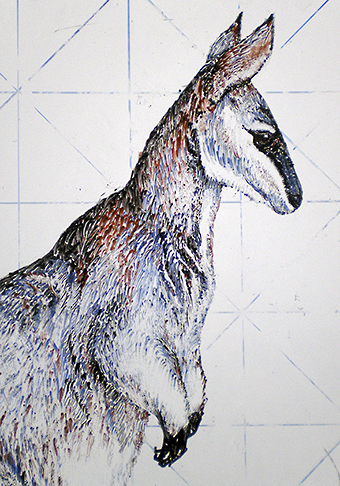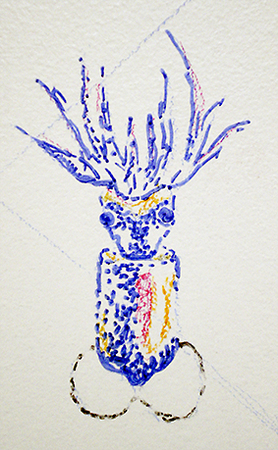 More on the drawing in IRG. Here is the Kangaroo Island emu, after Lesueur. This remarkable woolly bird was smaller than the mainland emus. It became extinct not long after European settlement in South Australia, due to foxes, habitat loss and "sport". This creature now only survives as an image so I thought he was appropriate for the Imaging group.  Detail of the Kangaroo Island emu, from the whiteboard in Bride Level 2, Image Resources Group
0 Comments
 I've been back down to IRG on Swinburne Level 2 to do some more work on the large whiteboard there. I'm getting better at rendering with the markers but strangely it doesn't feel any easier. There are very few colours in whiteboard markers so the limited palette is one of the big challenges of this project. I'm trying to translate subtle shades, colours and engraving into some kind of office stationery equivalent that still invokes a 19th century aesthetic. Good luck with that! Anyway, I drew up a more accurate outline drawing over my initial composition. The next day I started the tonal rendering of Grey's Wallaby  Had busy day on Saturday. I started a large drawing of a rakali from Ferdinand Bauer's natural history drawings. The drawing is in Rare Books, McArthur gallery. As usual, everything takes longer than you think it will. This whiteboard is glass (unlike the others so far) and very difficult to draw on. The markers were unpredictable and slippery and the drawing even more fragile to work than usual. This made for a long, hard morning of trial and error. It was lunchtime before I arrived at a technique that I was satisfied with. I was pretty sore and tired by the end of the day but I think it's going well.  Early outline drawing scaled up from a small printed draft of the whiteboard design. The image stretches across two separate glass panels 51x102cm each. That's a big rat.  Detail of the head using black and brown markers. I have to work from left to right to avoid rubbing the work out.  Two more whiteboards this week, both on a marine theme. The image to the left is whiteboard number 5 (I think) and features three fish from New South Wales, after Sarah Stone, from Journal of a voyage to New South Wales, (1789). The photo is taken at night and you can see the lights of the Newspaper Reading Room below reflected on the surface. I like this effect, it looks rather aquatic and dreamy. This is still the rough sketch. I've decided to work on the drawings in stages so people can see them evolve and have the process happening in a few places at once. It also gives me more time to think about each drawing as I go. This is a small whiteboard sitting over a cabinet in the walkway of the mezzanine over the Newspaper reading room. The second drawing is a lot bigger and more complex, in fact it will be the largest work in the project I think. It is a composition based on three plates by Lesueur from the voyage of Nicholas Baudin, 1800 to 1804. It's 220 x 258cm and fills the whole wall of the meeting room in Learning Services on Bride Level 3. The subject is "mollusques et zoophytes".  The meeting room on bride Level 3 is quite small and I wasn't able to fit the whole drawing in one shot. Here is a slightly lumpy photo montage of several shots to show the whole thing. I was astonished when I turned the page and saw the first of Lesueur's submarine wonders. They were so different to anything else I'd seen, full of unfamiliar creatures captured with great delicacy. It was such a different impression of the sea. The diaphanous jellyfish float on the page as they might in the ocean but for the soft folding of their tentacles in deference to the boundaries of the composition. Gravity behaves strangely in this gentle void of the imagination. Last week I completed the first whiteboard drawing. It is based on John Cotton's Great Spotted Honeysucker, from his second sketchbook, held in the manuscripts collection at SLV. This bird is commonly known as the Little Wattlebird today. There are several living in my front garden at home. They are noisy, bossy and agile, and love grevillea flowers. The image is located in Collection Interpretation, Armstrong Level 3.  I have started two more, a blue bellied parrot (rainbow lorrikeet) after sarah stone, from John White's Journal of a voyage to New South Wales : with sixty-five plates of non descript animals, birds, lizards, serpents, curious cones of trees and other natural productions. What a great title. These birds hang out in the big Lilli Pillys next door. How can something so bright be so invisible? It is nearly impossible to see them up in the trees. I thought this plumage was to make them stand out but clearly it is meant to camouflage. This image is located in the kitchen at the east end of Armstrong Level 4. Little bit more to go on this one. The third image is based on a work by Gould, of Grey's Wallaby, and one by Lesueur of the Kangaroo Island emu. Both animals are now extinct. This drawing is located in east IRG, at the east end of Swinburne Level 2. |
AuthorDominique Dunstan is a reference librarian and artist. She works at the State Library of Victoria and has recently completed the Jane Nicholas Staff Fellowship. Archives
July 2013
Categories |








 RSS Feed
RSS Feed